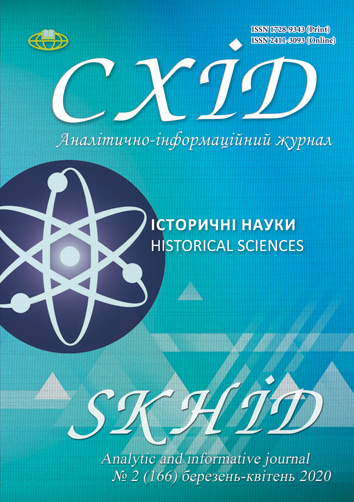Historical particularities of diplomacy at the turn of 20th - 21st centuries
DOI:
https://doi.org/10.21847/1728-9343.2020.2(166).200287Keywords:
diplomacy, public diplomacy, International Relations, agreements, negotiations, host country, parent countryAbstract
The suggested article analyzes the roots, evolution and contemporary development of diplomacy at the turn of 20th - 21st centuries. The actuality of the problem consists in the fact that in modern world the boundaries between domestic and foreign policies are constantly disappearing. Issues which were considered to be as an internal matter of one or another country, may be effectively addressed nowadays only on international level, using efforts of a great number of international actors. In democratic countries in contrast to authoritarian regimes, we can see a considerable dispersion of power and decision-making centers. Diplomats of these countries are not always confident if their activity will gain the support of parliamentary institutions and local authorities of their parent countries. All these factors lead to the necessity of study the peculiarities of modern diplomacy and its effectiveness in 21st century. The research is based on systematic method, which is manifested in alignment and consistency of the presentation of the material on the basis of analyzed sources. Another important method applied is a historical method by means of which chronological order of the development of modern diplomacy is systematized. The article emphasizes the essence of diplomacy, its basic aims and functions, political and non-political tasks of diplomatic activity. Diplomacy is regarded as set of scientifically established methods and means, the art of conducting negotiations and concluding agreements, the art of realizing state foreign policy goals. The research highlights a new approach to the analysis of public diplomacy regarding it as a practical activity and important mean for achieving strategic purposes in the international arena in the process of active globalization at the beginning of 21st century.Downloads
References
Arsenault, A. (2009). Public Diplomacy 2.0. Toward a New Public Diplomacy. New York: Palgrave Macmillan, 135-253.
Bieliei, S. (2012). Publichna dyplomatiia derzhav serednoi syly v suchasnykh mizhnarodnykh vidnosynakh: dosvid Kanady ta Niderlandiv. Naukovi pratsi. Politolohiia, 185(197), 72-77. (In Ukrainian)
Brown, C. and Ainley, K. (2005). Understanding International Relations. Basingstoke, Palgrave Macmillan, 91 p.
Definition of diplomacy in English. Oxford Dictionary. Retrieved from: https://en.oxforddictionaries.com/definition/diplomacy.
Holbrooke, Richard (2001, October 28). Get the Message Out. The Washington Post. Retrieved from: https://www.washingtonpost.com/archive/opinions/2001/10/28/get-the-message-out/b298b3c9-45b8-45e2-9ec7-20503dd38802/?noredirect=on&utm_term=.9025bfac8f47.
Hutsal, S. A. (2010). Publichna dyplomatiia yak suchasnyi priorytet zovnishnoi polityky derzhavy. Stratehichni priorytety, 3(16), 106-114. (In Ukrainian)
ICT Data and Statistics (IDS) (2008). ITU. Retrieved from: http://www.itu.int/ITU-D/ict/statistics/ict/.
Ivanova, N. S. (2017). Publichna dyplomatiia yak efektyvnyi mekhanizm zovnishnoi polityky derzhavy. Visnyk KhNU im. V. N. Karazina, seriia «Pytannia politolohii», 32, 121-126. (In Ukrainian)
Kyntsans, V. P. (1992). Dyplomatycheskyi protokol. Ryha, 253 p. (In Russian)
Leonard, M. (2002). Diplomacy by other means. Foreign Policy, 132, 48-56.
Malskyi, M. Z., Moroz, Yu. M., Kuchyk, O. S. et al. (2014). Ukrainskyi dyplomatychnyi slovnyk. Kyiv: Znannia, p. 218 (In Ukrainian)
Melissen, J. (2005). The New Public Diplomacy: Soft Power in International Relations. Britain: Palgrave Macmillan, 221 p.
Melissen, Jan (2011). Beyong the new public diplomacy. Netherlands institute of IR Clindgendael. Retrieved from: https://www.clingendael.org/sites/default/files/pdfs/20111014_cdsp_paper_jmelissen.pdf.
Nai, Dzhozef S. (2010, Lutyj 18). Nova publichna dyplomatiia. Den, 28. (In Ukrainian)
Nelles, W. (2004). American public diplomacy as pseudo-education. International Politics, 41, 65-93.
Ociepka, B. (2015). Miękka siła i dyplomacja publiczna Polski. Historia i Polityka, 13(20), 207-209. DOI: http://dx.doi.org/10.12775/HiP.2015.015.
Palmer, N. F. and Perkins, H. C. (2001). International Relations. CBS, 799 p.
Rudenko, H. M. (1999). Ukraina dyplomatychna. Kyiv, 258 p. (In Ukrainian)
Ruthven, M. (2013). Carving Up the Globe - An Atlas of Diplomacy. Harvard University Press, 256 p.
Satow, E. (2015). A Guide To Diplomatic Practice. Andesite Press, 446 p.
Signitzer, B. and Coombs, T. (1992). Public relations and public diplomacy: Conceptual covergences. Public Relations Review, 137-147.
Strachan, F. (2001). The Evolution of Stalins Foreign Policy during Word War Two. E-International relations. Retrieved from: https://www.e-ir.info/2011/11/23/the-evolution-of-stalins-foreign-policy-during-word-war-two/.
The Oxford Encyclopedia of American Military and Diplomatic History (2013). Oxford University Press. Retrieved from: https://www.oxfordreference.com/view/10.1093/acref/9780199759255.001.0001/acref-9780199759255.
Tsvetkova, N. A. (2011). Programmyi Web 2.0 v publichnoy diplomatii SShA. SShA i Kanada: Ekonomika, politika, kultura, 3, 109-122. (In Russian)
Vud, Dzh and Serre, Zh. (1978). Dyplomatycheskyi tseremonyal y protokol. Moscow: Prohress, 395 p. (In Russian)
What is Public Diplomacy? (2008). Public Diplomacy Alumni Association. Retrieved from: http://www.publicdiplomacy.org/1.htm
Wolf, Charles Jr. and Rosen, Brian (2004). Public Diplomacy: How to Think About and Improve It. RAND Corporation, Retrieved from: https://www.rand.org/content/dam/rand/pubs/occasional_papers/2004/RAND_OP134.pdf.
Zakon Ukrainy pro dyplomatychnu sluzhbu (2018). Retrieved from: https://zakon.rada.gov.ua/laws/show/2449-19. (In Ukrainian)
Downloads
Published
How to Cite
Issue
Section
License
Copyright (c) 2020 Oleksandra Sahaidak, Khrystyna Sholota

This work is licensed under a Creative Commons Attribution-NonCommercial-NoDerivatives 4.0 International License.
1. Authors bear responsibility for the accuracy of facts, quotations, numbers and names used.
2. Manuscripts are not sent back.
3. The publisher does not always agree with the authors' opinion.
4. The authors reserve the right to authorship of the work and pass the first publication right of this work to the journal under the terms of a Creative Commons Attribution-NonCommercial-NoDerivatives 4.0 International License. This license allows others to distribute (copy) the published work for non-commercial purposes, provided there is mandatory attribution to its authors and a link to the first publication in our journal.
5. The authors have the right to conclude separate supplement agreements that relate to non-exclusive work distribution in the form in which it has been published by the journal (for example, to upload the work to the online storage of the journal or publish it as part of a monograph), provided that the reference to the first publication of the work in this journal is included.

